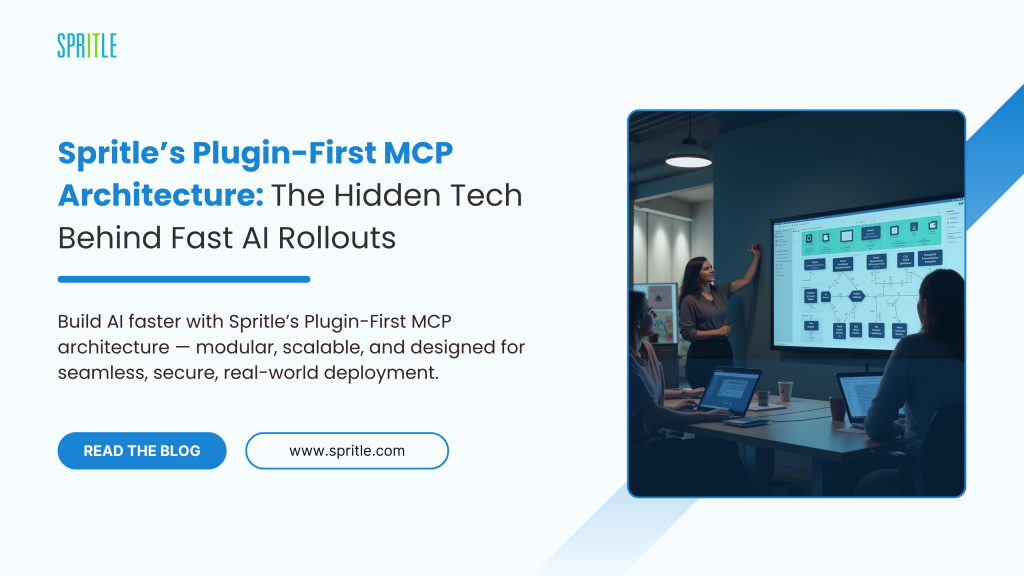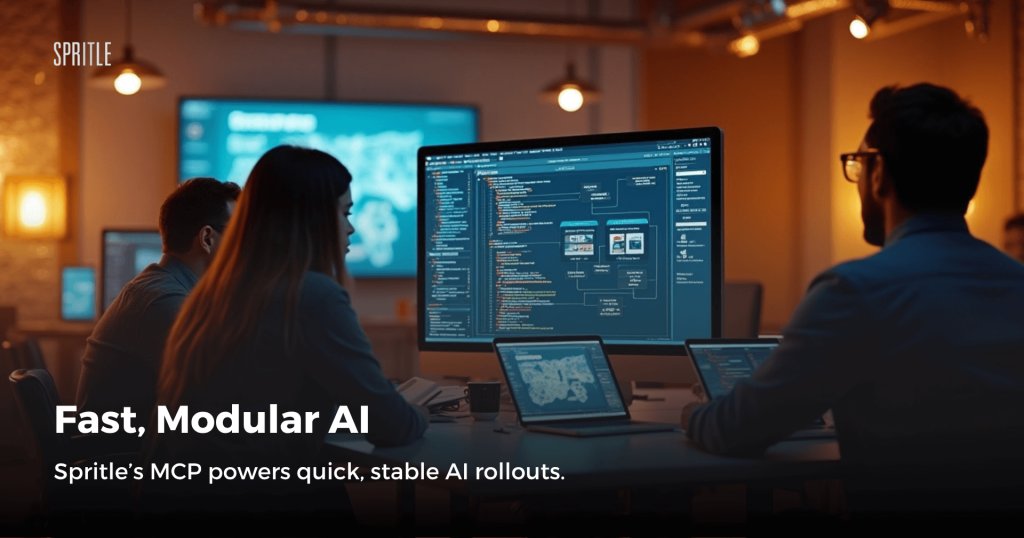
Introduction
In the fast-moving world of AI, time-to-market can be the difference between industry leadership and playing catch-up. For business owners and product leaders, the promise of AI is no longer just theoretical — it’s operational.
But behind every smooth AI rollout lies an often-overlooked secret: architectural design. At Spritle, we’ve engineered that edge with our Plugin-First Modular Component Platform (MCP) architecture.
Let’s explore how this invisible infrastructure helps us move faster — and smarter.
Why Speed with Stability Matters
Everyone wants to ship faster. But not everyone can do it without breaking things. AI features — from chatbots to predictive engines — often demand complex integrations, model tuning, and compliance checks.
Too often, companies end up with a mess: rigid backends, tangled APIs, and rollout delays.
The truth? Fast doesn’t have to mean fragile.But it does require foundations designed for speed and flexibility. That’s where architectural choices come in — and where Spritle’s MCP model shines.

What Is a Plugin-First MCP?
Imagine building your product like a LEGO kit — not a concrete wall.
Our Modular Component Platform (MCP) is designed with a plugin-first philosophy, meaning:
- Every AI feature is developed as an individual plugin.
- Plugins can be added, removed, or replaced without disturbing the core system.
- Each module is reusable, independently testable, and easily integrated with external tools.
This enables teams to:
- 🚀 Build in parallel
- 🧪 Test quickly and safely
- 🔄 Pivot without starting over
In essence, it gives you the agility of a startup with the reliability of an enterprise framework.
Real-World Example: AI for Document Automation in Fintech
One of our clients — a fintech startup — needed to streamline loan processing with smart document handling.
Instead of:
- Building custom modules for OCR, fraud detection, and data verification
- Waiting 6+ months for a complete rollout
We used our Plugin-First MCP to:
- 📄 Plug in an OCR component that could switch between open-source and Azure’s Vision API
- 🧠 Attach a pattern-detection model for fraud signals
- 🖥️ Embed a review plugin for human verification
Result?
A fully operational AI pipeline in just 6 weeks, all without vendor lock-in.
Each module was independently developed, plugged into the system, and could be swapped or upgraded without touching the others.
🏗️ Anatomy of the Architecture
Our architecture has four essential layers:
- Core Engine – Orchestrates plugin behavior and API logic
- Plugin Layer – Houses all feature logic, including AI models and integrations
- Integration Layer – Connects to frontend apps, CRMs, EHRs, and more
- Observability Suite – Tracks logs, errors, plugin health, and version control
This modular structure isn’t just theoretical — it powers real, live products every day.
Benefits Beyond Speed
Most businesses don’t just want to build fast — they want to build safely, scalably, and with the freedom to evolve.
With our plugin-first approach, clients can:
- Swap out models as new tech emerges
- Customize logic without waiting on core updates
- Run A/B tests on AI plugins
- Scale individual modules instead of entire systems
This translates into more innovation, fewer delays, and less tech debt.
However, developer velocity and morale are arguably the most underappreciated advantage. Teams can concentrate on invention rather than putting out fires when there are defined boundaries and reusable components. Better code, fewer defects, and happier engineers are the results of this, and they all have a direct effect on the quality of the final product.
Dispelling the Myth That “No-Code Fixes Everything”.
Busting the “No-Code Fixes Everything” Myth
No-code AI tools promise plug-and-play simplicity. And yes — they’re improving. But most still lack:
- Contextual awareness
- Enterprise-grade flexibility
- Seamless integration with internal systems
Without expert guidance, these tools often become islands of functionality — not production-ready solutions.
Spritle’s plugin-first MCP brings the best of both worlds: rapid development and professional-grade architecture.
Here’s a simple example: imagine a product owner wants to use a no-code tool like Bolt to launch an AI customer service feature. It might work initially. But when they need to connect it to internal CRMs, enforce GDPR compliance, and scale it across departments — things start to fall apart.
That’s where Spritle steps in. With our MCP, we can plug in AI copilots like Bolt, Lovable, or custom models, and wrap them in logic, controls, and integrations that match your real-world business needs.
🔮 Is Plugin-First the Future?
We believe so.
As AI moves from novelty to necessity, modularity will separate the tools that last from the ones that don’t scale.
A plugin-first approach:
- Reduces vendor lock-in
- Encourages clean interfaces
- Supports domain-specific customization
- Future-proofs your product against the next wave of AI
It also gives decision-makers what they’ve always wanted but rarely get: visibility, flexibility, and confidence.
The result is not just better products — it’s better product thinking.
📊 Bonus: Business Impact Metrics We’ve Seen
When we implement MCP, clients report measurable improvements:
- 📉 40–60% reduction in time-to-market
- 🧩 30% fewer bugs post-deployment
- 🔄 Easier onboarding for new developers
- 💬 Increased stakeholder satisfaction from faster feedback loops
These aren’t theoretical gains — they’re operational upgrades that ripple across engineering, product, sales, and customer support.
💡 Final Thoughts
The next time you hear someone say,
“We need AI, and we need it fast,”
ask this instead:
“What kind of architecture are we building it on?”
Speed doesn’t come from hustle alone. It comes from clarity, modularity, and trust in your foundations.
At Spritle, we’ve made the investment in that foundation — so you don’t have to.
And if your AI roadmap is feeling more like a roadblock lately, maybe it’s not your ambition that’s holding you back.
Maybe it’s your architecture.
✅ Rethink how you build your next AI product — not just for speed, but for sustainability.
